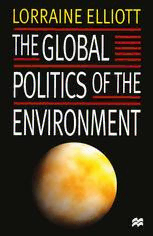
The Global Politics of the Environment PDF
Preview The Global Politics of the Environment
The Global Politics of the Environment Also by Lorraine Elliott INTERNATIONAL ENVIRONMENTAL POLITICS: Protecting the Antarctic PROTECTING THE ANTARCTIC:Australia and the Minerals Convention The Global Politics of the Environment Lorraine Elliott © Lorraine Elliott 1998 All rights reserved.No reproduction, copy or transmission of this publication may be made without written permission. No paragraph of this publication may be reproduced, copied or transmitted savewith written permission or in accordance with the provisions of the Copyright, Designs and PatentsAct 1988, or under the terms ofany licencepermitting limitedcopying issued by the Copyright LicensingAgency,90Tottenham Court Road, London WIP 9HE. Any person who does any unauthorised act in relation to this publication may be liable to criminal prosecution and civil claims for damages. The author has asserted her right to be identified as the author ofthis work in accordance with the Copyright, Designs and Patents Act 1988. First published 1998by MACMILLAN PRESS LTD Houndmills, Basingstoke, Hampshire RG21 2XS and London Companies and representatives throughout the world ISBN 978-0-333-63367-0 ISBN978-1-349-26033-1 (eBook) DOI 10.1007/978-1-349-26033-1 A catalogue record for this book isavailable from the British Library. 10 9 876 543 2 1 07 06 05 04 03 02 01 00 99 98 Copy-edited and typeset by Povey-Edmondson Tavistock and Rochdale, England For Matthew, Loren, Louise and Benjamin Contents Acknowledgements x List of Abbreviations xii Introduction 1 Structure of the Book 4 1 From Stockholm to Rio 7 Before Stockholm 8 The United Nations Conference on the Human Environment 11 Stockholm to Rio: The In-Between Years 13 United Nations Conference on Environment and Development 17 Conclusion 25 2 The Transboundary Agenda:Conservation and Pollution 27 Introduction 27 Protecting Wildlife and Conserving Living Resources 28 Transboundary Pollution: Dispersal and Displacement 37 Managing Hazardous Waste 44 Conclusion 51 3 The Emergenceof a Global Agenda 52 The Global Commons of the Atmosphere: Ozone Depletion 53 The Global Commons of the Atmosphere: Climate Change 60 Global Heritage or Sovereign Resources: Biodiversity 73 Global Heritage or Sovereign Resources: Deforestation 80 Common Interest and Global Burden Sharing: Desertification 89 Conclusion 94 vii viii Contents 4 The State and Global Institutions 96 Introduction 96 The Inadequate State? 98 International Environmental Law 100 Institutional Reform 105 The United Nations 107 Moving Beyond Reform: The Critical Position 117 5 Non-State Actors: Science, Commerce and Global Civil Society 120 Scienceand Environmental Governance 120 Business, Industry and Environmental Governance 123 Global Civil Society 129 Non-Governmental Organisations: Movements to Save the Planet? 131 Conclusion 145 6 Voices from the Margin: Women andIndigenous Peoples 147 Holding the Keys: Women and the Environment 147 Humanity's Hope? Indigenous Peoples and the Environment 157 7 The International Political Economy ofthe Environment 169 North and South 169 Whose Common Agenda? 173 Common but Differentiated Responsibilities 176 Sustainable Development 179 8 Strategies for Sustainable Development 192 Enhancing the Flow ofResources to Developing Countries 192 Debt and the Environment 204 Trade and the Environment 207 Market-Based Financial Mechanisms 215 Conclusion 217 9 Environmental Security 219 Introduction 219 Militarising Environmental Politics: The Environment and Security 220 Contents ix Demilitarising Security: Securing the Environment 231 Revisiting Environmental Security 240 10 The Global Politics of the Environment 242 Problem-Solving and Critique 243 Evaluating the Contemporary World Order 248 Future Conditional? 253 Further Reading 258 Bibliography 262 Index 300 Acknowledgements The process of writing an international account of global environ mental politics has led me to incur debts to colleagues around the world. Many ofthese debts have arisen not justin the writing of this specific book, but in the willingness of many to spend time talking with me about global environmental politics generally, providing a supportive community of scholars and enabling me to test ideas through seminars, conference papers and publication. They have, at all times, been encouraging of my work even as they required me to strengthen my own arguments when, as happens, they called me to account for my views.They may not have realised, at the time, that they were contributing in various ways to the development of the ideas that appear in this book, and perhaps neither did I. In various ways,then,and forvarious reasons Iwouldliketo thank Marc Williams, Julian Saurin, Matt Paterson, Ian Rowlands, Dave Scrivener, Peter Newell, Mark Imber, Hugh Dyer and John Vogler; Lois Lorentzen and Jennifer Turpin; Gwyn Prins; Kristalina Geor gieva; Helen Freeman (and the staffat WorldWIDE); Ann Tickner, Maureen Molot, Kim Nossal, Martin Rudner, Stuart Harris, Kate Manzo,Joe Camilleriand Andy Mack;and AliBos,Adam Cunning ham, Deb Foskey and Johanna Sutherland (the last four, my post graduates, all of whom are working on environment-related issues). The writing ofthis book has beenwovennotjustwithmyresearch on a range of environmental issues and problems but also with my teaching on this subject matter. Thanks are due therefore to the undergraduate and honours students who have taken my global environmental politics courses over the last four years. Sue Fraser did a sterling job of checking and, where necessary, chasing up references, a task which required her to read through the whole manuscript (for which I am very grateful: she bears no responsibility for any errors). Steven Kennedy has been a strict but supportive publisher and his encouragement has been central to the completion of this book. I should like also to acknowledge financial support from the Australian National University New Staff Grant scheme and the Australian Research Council Small Grants for some of the research on NGOs which appears in this book. x
